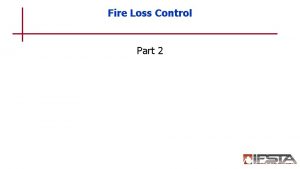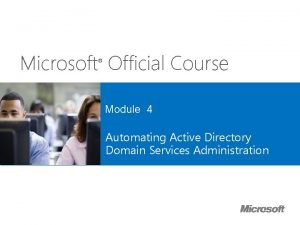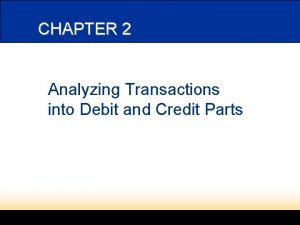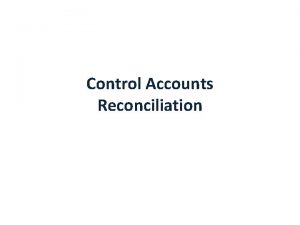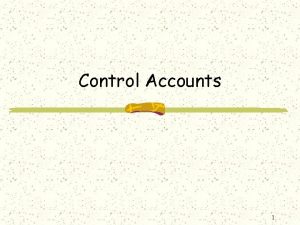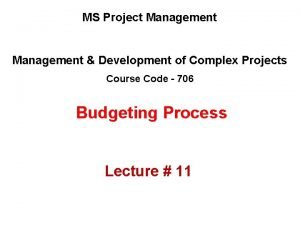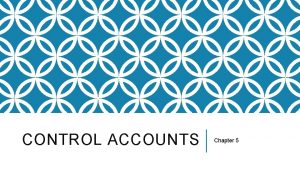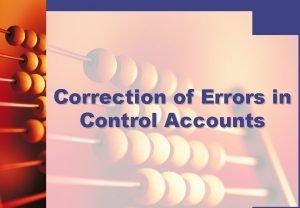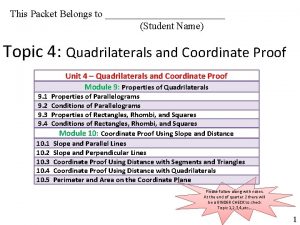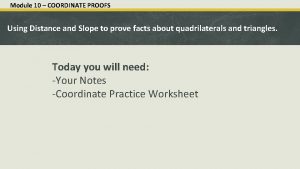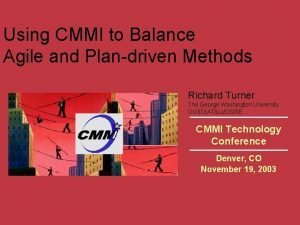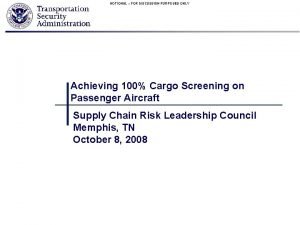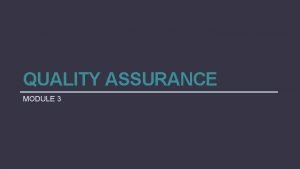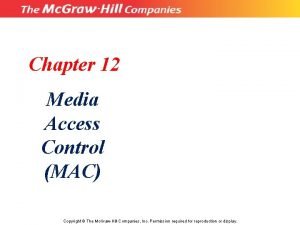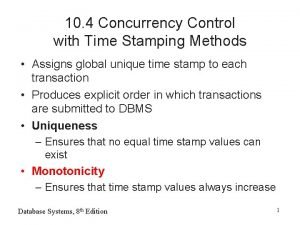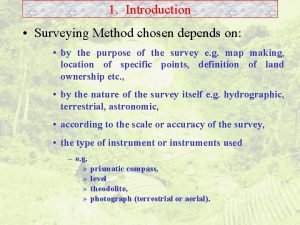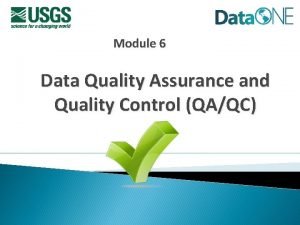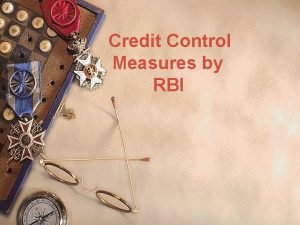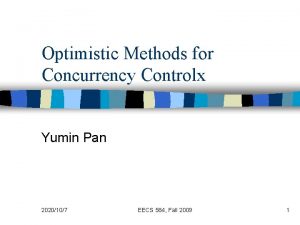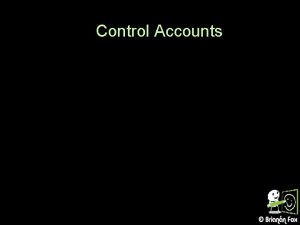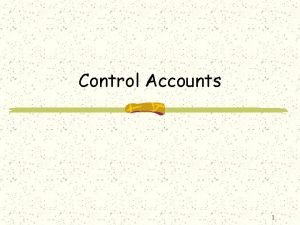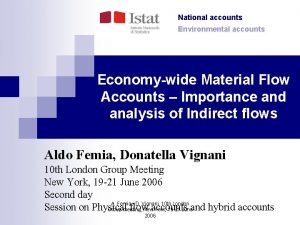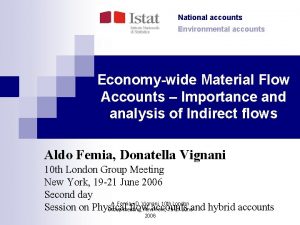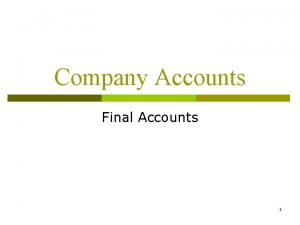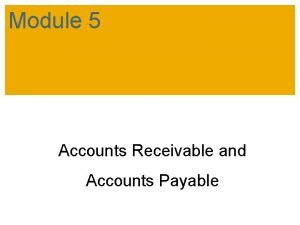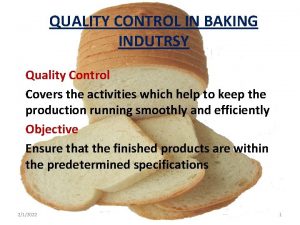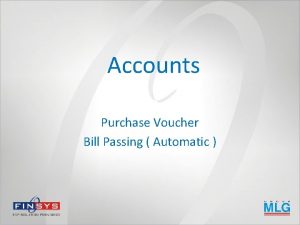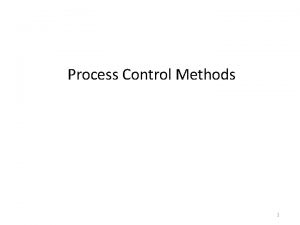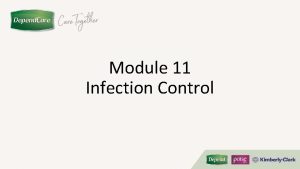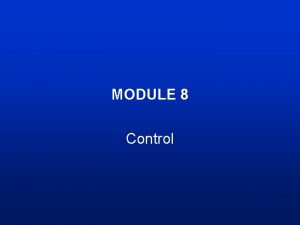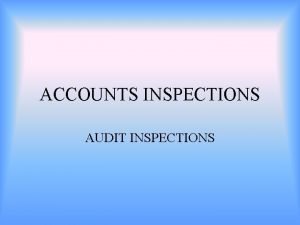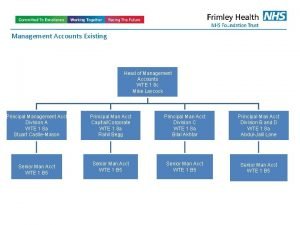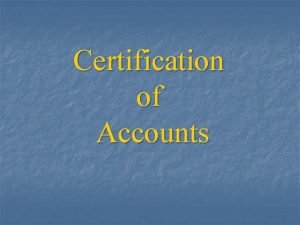Using Control Accounts This Module Covers Methods of



























- Slides: 27

Using Control Accounts

This Module Covers: • Methods of payment. Notes in Dropbox, not covered in lessons. • The bank account. • Using control accounts. • Reconciling the bank account. • The journal. • Wages control account. • Correction of errors in the trial balance.

Aims of the Session • • • Understand the use & purpose of control accounts. How control accounts work. Prepare SLCA, PLCA and VAT accounts. Reconcile control accounts. Aged balances.

Quick Recap of Bookkeeping Transactions Five stages of the accounting system?

5 Stages of the Accounting System • • • Stage 1 – Financial transaction takes place. Stage 2 – Financial document generated. Stage 3 – Entry into the books of prime entry. Stage 4 – Entry into the ledger accounts. Stage 5 – Trial balance.

Books of Prime Entry?

Books of Prime Entry • • Sales day book Purchase day book Sales return day book Purchase return day book Discount allowed day book Discount received day book Cash book ( normally refers to bank account as well as cash transactions) • Petty cash book • The journal

What Are Control Accounts • ‘Master’ accounts which control subsidiary accounts. • Records total transactions going through the subsidiary accounts. • Balances of the control account and subsidiary accounts should always match.

Hierarchy of Control Accounts Control Account Subsidiary Account

Sales Ledger Control Account SLCA Sales Ledger Part of the double entry system Sales Ledger Not part of the double entry system Sales Ledger

Why Use Control Accounts? • Instant information. • Prevention of fraud. • Locating errors.

Commonly Used Control Accounts • Sales Ledger Control Account (SLCA or Trade Receivables) • Purchase Ledger Control Account (PLCA or Trade Payables) • VAT Control Account • Wages Control Account

The SLCA • Sales Day book is totalled (if necessary) and entered into the individual sales ledgers. • The total from the ledger account is then posted to the SLCA in the general ledger. • Subsequent double entries in the general ledger then take place. • The same happens for the PLCA, the entries are reversed.

Layout of the SLCA Bal b/d Bank Sales Discounts Allowed Returned cheques Sales Returns Irrecoverable debts Contra Bal c/d Bal b/d

What It All Means. . . Debit Transactions Credit Transactions • Bal b/d - Balance brought down • Sales • Returned cheques also known as dishonoured cheques • • • DE AD CLIC INCREASING Assets Bank Discounts Allowed Sales Returns Contra or offset entry Irrecoverable debts or bad debts

Information Sources for SLCA • Total credit sales from Sales Day Book. • Total credit sales returns from Sales Returns Day Book. • Bank from remittance advice or cash book • Discount Allowed from cash book or discount allowed day book. • Irrecoverable debts from the journal or write off account.

Reconciling the SLCA • Simple arithmetical check. • List and total the transactions in the subsidiary ledgers. • Check the amount against the SLCA. • Investigate any errors.

Aged Balances Aged Trade Receivables Trade Receivable Total 0 -30 days 31 - 60 days 61+ days Adams Ltd T Brewster Harrison D Miller £ 3, 510 1, 840 760 2, 330 £ 0 1, 620 760 330 £ 0 220 0 2, 000 £ 3, 510 0 Totals 8, 440 2, 710 2, 200 3, 510

PLCA Reverse it all!

Layout of the PLCA Details Purchase Returns £ Details Purchases Bank Discount Received Contra Bal c/d Bal b/d £

What It All Means. . . Debit Transactions Credit Transactions • • • Balance brought down • Purchases Bank Discount received Purchase returns Contra or off set entries Balance carried down DEAD C LIC INCREASING Liabilities

Information Sources for PLCA • Purchases day book. • Purchase returns day book. • Cheque book/cash book. • Discount received column of cash book or discount received day book.

The VAT Control Account • Totals from books of prime entry. • Must reconcile with the VAT return. • Tells the business what is owed to or from HMRC.

VAT Control Account VAT Details £ Details Purchases Sales Returns Purchase returns Cash purchases Cash sales Other expenses Other cash income Bank Other income Bal c/d? ASSETS LIABILITIES £

Discrepancies • What if the control account doesn’t match the subsidiary ledgers? • Establish what has the greater balance. • Decided where the problem may lie and investigate it.

Questions?

Exercises
 Methods for salvage covers
Methods for salvage covers Lab 5: manage active directory accounts (module 4)
Lab 5: manage active directory accounts (module 4) C device module module 1
C device module module 1 Metal coping fpd
Metal coping fpd 4-4 using t accounts to analyze transactions
4-4 using t accounts to analyze transactions What is a control account in financial accounting
What is a control account in financial accounting Bad debts written off in control accounts
Bad debts written off in control accounts Control accounts project management
Control accounts project management Debtors control
Debtors control Correction of errors in accounting questions
Correction of errors in accounting questions Perimeter formula
Perimeter formula Module 10 coordinate proof using slope
Module 10 coordinate proof using slope Using risk to balance agile and plan driven methods
Using risk to balance agile and plan driven methods Bluetooth positioning using rssi and triangulation methods
Bluetooth positioning using rssi and triangulation methods The iac must ensure custody of air cargo using what methods
The iac must ensure custody of air cargo using what methods Qa checklist example
Qa checklist example Methods of water pollution
Methods of water pollution Media access control methods
Media access control methods Methods of portion control in bread and pastry
Methods of portion control in bread and pastry Taping definition in surveying
Taping definition in surveying Quality control methods for medicinal plant materials
Quality control methods for medicinal plant materials Chemical engineering nmsu
Chemical engineering nmsu Concurrency control with time stamping methods
Concurrency control with time stamping methods Methods of establishing control points in surveying
Methods of establishing control points in surveying Air pollution control methods
Air pollution control methods What is quality control definition
What is quality control definition How are crr and slr used as credit control measures
How are crr and slr used as credit control measures On optimistic methods for concurrency control
On optimistic methods for concurrency control
